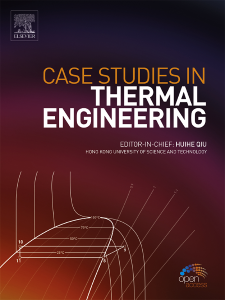Prediction of zinc evaporation in the snout of high-temperature hot-dip zinc-aluminum-magnesium coating line
IF 6.4
2区 工程技术
Q1 THERMODYNAMICS
引用次数: 0
Abstract
The internal flow field of snout affects the quality of hot-dip zinc products significantly. The prediction of zinc evaporation is a key issue of analyzing the atmosphere flow in the snout. In this paper, simulations of the atmosphere flow with zinc evaporation considered are carried out in the snout of a high temperature hot-dip zinc-aluminum-magnesium coating line. In order to eliminate the false diffusion in numerical calculation of zinc evaporation, a strategy of high-order scheme combined with local orthogonal grids at the zinc vaporization boundary is proposed. The simulation is validated by available experimental data. The effects of operation parameters such as the temperature of snout wall, the width and the speed of the strip on the zinc vapor flow are studied. It is found that with the increased temperature gradient between the snout wall and strip wall, the concentration of zinc vapor in the snout is also increased. Therefore, the method of heating the snout wall can reduce the temperature gradient between the snout wall and strip wall, so it is beneficial to reduce the evaporation of zinc liquid in the snout.
高温热浸锌铝镁涂层生产线喷嘴锌蒸发量预测
喷嘴内部流场对热浸锌产品质量影响很大。锌蒸发的预测是分析喷嘴内气流的关键问题。本文对高温热浸锌-铝-镁镀膜生产线喷口内考虑锌蒸发的气氛流动进行了模拟。为了消除锌蒸发数值计算中的错误扩散,提出了在锌蒸发边界采用高阶方案与局部正交网格相结合的策略。现有的实验数据对模拟进行了验证。研究了喷嘴壁温度、带材宽度和速度等运行参数对锌蒸发流的影响。结果发现,随着喷嘴壁和板带壁之间温度梯度的增加,喷嘴中锌蒸汽的浓度也随之增加。因此,加热喷嘴壁的方法可以减小喷嘴壁和带状壁之间的温度梯度,从而有利于减少喷嘴中锌液的蒸发。
本文章由计算机程序翻译,如有差异,请以英文原文为准。
求助全文
约1分钟内获得全文
求助全文
来源期刊

Case Studies in Thermal Engineering
Chemical Engineering-Fluid Flow and Transfer Processes
CiteScore
8.60
自引率
11.80%
发文量
812
审稿时长
76 days
期刊介绍:
Case Studies in Thermal Engineering provides a forum for the rapid publication of short, structured Case Studies in Thermal Engineering and related Short Communications. It provides an essential compendium of case studies for researchers and practitioners in the field of thermal engineering and others who are interested in aspects of thermal engineering cases that could affect other engineering processes. The journal not only publishes new and novel case studies, but also provides a forum for the publication of high quality descriptions of classic thermal engineering problems. The scope of the journal includes case studies of thermal engineering problems in components, devices and systems using existing experimental and numerical techniques in the areas of mechanical, aerospace, chemical, medical, thermal management for electronics, heat exchangers, regeneration, solar thermal energy, thermal storage, building energy conservation, and power generation. Case studies of thermal problems in other areas will also be considered.
 求助内容:
求助内容: 应助结果提醒方式:
应助结果提醒方式:


